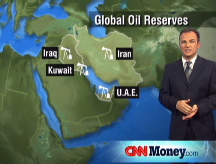Oil rises despite falling demand
Analyst says prices can go to $150 a barrel, even as U.S. demand for oil-based products continues to slump.
NEW YORK (CNNMoney.com) -- Oil prices moved higher Wednesday despite a stronger dollar and signs that U.S. demand for oil products is waning in light of a slumping economy and record prices.
Oil fell nearly $3 earlier in the day, but rebounded after Morgan Stanley's co-head of global economics, Richard Berner, said crude prices could easily reach $150 a barrel this year, and that high prices will not be enough to curb demand in developing countries.
"It seems that these big banks are driving oil prices, where instead it used to be the other way around," said Alaron Trading senior market analyst Phil Flynn.
As the U.S. economy has deteriorated in the past six months, many investors have engaged in speculative trading of commodities such as oil to serve as a hedge against a generally weakened dollar. Banks' predictions of rising prices only gives credence to oil traders that their investment will deliver a strong return.
Light, sweet crude oil for July delivery rose $2.18 to settle at $131.03 on the New York Mercantile Exchange. The contract fell $3.34 Tuesday, and was about $4 off its all-time high of $135.09 a barrel, which it hit last Thursday.
Traditionally, there is a run-up of crude oil future purchases just prior to Memorial Day as traders anticipate a strong start to the summer driving season. But since forecasts by motorist group AAA and Delloite and Touche both expected decreased travel this past holiday weekend, analysts said lower gasoline demand in the United States may finally be catching up to record oil prices.
"There is a very limited demand for fuel oil in the U.S.," said Stephen Schork, editor of energy industry newsletter The Schork Report. "Consumers are responding to high prices, which makes the rapid rise in crude oil of the last few weeks hard to sell."
Though actual numbers for Memorial Day travel will not be known for some time, evidence is pointing to fewer Americans driving due to high gas prices.
The national average price for retail gas rose 0.7 cent a gallon to $3.944 Wednesday, marking the 21st straight record, according to AAA.
The U.S. Department of Transportation said Monday that Americans drove 11 billion miles less in March 2008 than a year earlier, marking the first time that estimated March travel on public roads fell since 1979. That 4.3% decline is the sharpest year-on-year drop for any month in the history of the agency's reporting, which dates back to 1942.
According to the Energy Information Administration (EIA), a unit of the U.S. Department of Energy, gasoline demand has fallen 0.6% so far in 2008. The trend began in October 2007, and gas consumption has trailed year-ago levels in every month since, except for a very slight bump up in November. As a result, the EIA is forecasting the first year-over-year decline in U.S. gasoline demand since 1991.
"The forecast for a decline in gasoline demand is a function of prices and also lower economic growth," said EIA spokesman Jonathan Cogan.
MasterCard (MA) SpendingPulse, which reports on national retail gasoline sales based on aggregate sales activity in the company's payments network, paints an even bleaker picture for gasoline demand. The report shows the four-week average for U.S. gasoline demand down 6.3% year-over year for the week ending May 23, representing the 15th-straight week in which that measure has been in negative territory. The data couples the company's credit card sales with estimates for all other payment forms, including cash and check.
"Consumer behavior has changed dramatically this spring," said MasterCard SpendingPulse vice president Michael McNamara. "We haven't seen the spring increase that we normally do."
McNamara said one indicative trend can be found in Americans spending less on gas heading into weekends than going into the work week. He said that suggests people are cutting back on discretionary driving, while still fueling up for non-discretionary purposes.
Other oil-based products are also experiencing declining U.S. demand, such as jet fuel, heating oil, diesel and propane. The EIA expects demand for all finished petroleum products to fall in the United States in 2008.
Some Americans are replacing their oil product consumption with natural gas. Demand for natural gas is up in the United States, according to the EIA, and for those residents and companies that have the option, the alternative fuel source can be a cheaper option.
"Industries that can burn it are maxing out their natural gas production, since it is is cheap relative to the other commodities," said Schork. Schork noted that demand was so high this past winter, that suppliers are having trouble refilling reserves.
Although demand for oil products in foreign countries has steadily risen throughout 2008, that may soon change due to continually escalating prices.
Some analysts, such as Morgan Stanley's Berner, say high prices will not affect oil consumption abroad, since many foreign countries' governments subsidize oil prices for their residents. But other analysts think foreign demand will soon fall off as well.
"We're already seeing some developing countries lift their price curbs, and eventually other countries are gong to have to pass on these high prices," said Flynn. "People underestimate what kind of effect high prices are going to have there." ![]()




